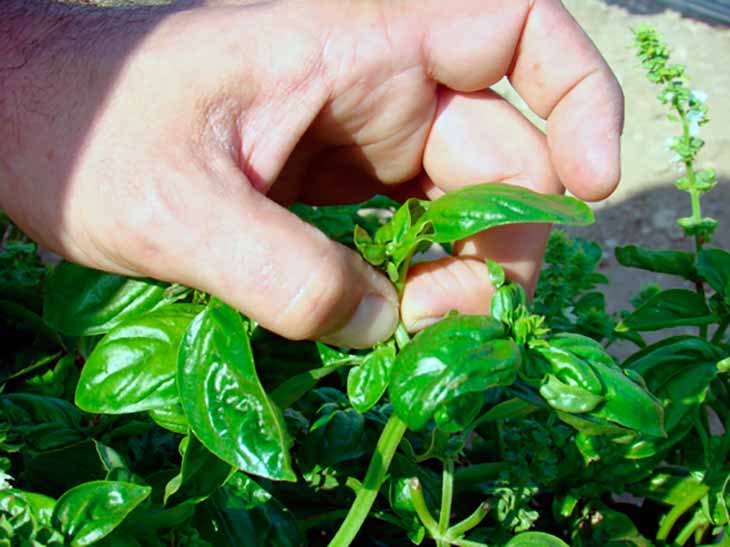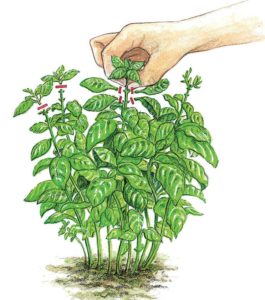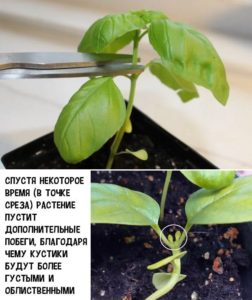When and how to pinch basil correctly and why this procedure is needed
Basil is a spicy herbaceous plant with a pleasant aroma. It is used to prepare many dishes of Italian and Slavic cuisine. The herb gives food a special taste. The spice is grown on balconies and garden plots. To get the maximum yield of the fragrant plant, basil is pinched.
Why pinch basil?

Pruning the apical branches is called pinching or pinching. The procedure is simple and does not require much experience. It is performed to limit the vertical growth of basil, which promotes increased growth of lateral branches.
Thanks to pinching, the bush thickens and branches abundantly. The stronger basil branches, the more leaves it produces. Because of this, the procedure is regularly repeated to maintain the splendor of the bush. The torn off tops are used for preparing dishes and various drinks.
In addition to pinching the apical shoots, the flower stalks must also be removed. This is done to prevent flowering. If basil begins to bloom, the plant stops forming young shoots. Trimming flower stalks also provokes severe thickening.
Is it necessary to do this?
Gardeners' opinions are divided regarding whether this procedure is mandatory. Some people believe that pinching is necessary, since without this you won’t get a big harvest. Others argue that it is enough to remove the flower stalks, but there is no need to pinch them.
With proper care, bushes that are not pinched also produce a good harvest. But still, most people involved growing basil, perform this procedure.
If you do not pinch the plants, the basil stem will gradually begin to become bare, causing the yield to decrease. To obtain the same amount of spice, you will have to plant more beds.
Important! The pinching procedure makes the plants compact and bushy.
Timing of the procedure
It is impossible to give exact dates. Pinching is performed depending on the stage of plant development.
When to pinch basil:
- More than 20 days have passed since the emergence of seedlings. During this time, the plants managed to get stronger.
- 6 true leaves appeared on the stems (excluding cotyledons).
After this, pinching is carried out once every 3-4 weeks. Peduncles are removed before flowering begins.
Important! The plants tolerate the absence of pinching well, but the flower stalks must be removed.
How to properly pinch basil
The procedure is simple. The main thing is to know the nuances of its implementation.
Step by step guide for beginners

Pinching is carried out as follows:
- Wait until 6 true leaves appear on the bush.
- Pinch off or cut off the apical part of the stem, which has just begun to emerge from the axil of the upper leaves.
- If the timing of pinching has already been missed and the 4th pair of leaves has appeared on the stem, the top is cut off along with them.
- After the inflorescences appear, the bud is removed along with one pair of leaves, which are located lower along the stem.
The removed parts are eaten. If pinching has already been done, and a couple of leaves are needed for cooking, they are carefully cut off from the side parts in the place where the petiole departs from the main stem.This way the bush can continue to develop normally and remain healthy.
After pinching, instead of 1 top shoot, 2 will appear on the basil. When the procedure is repeated, the number of branches increases, but the plant itself remains compact.
Mistakes to Avoid
 Pinching is a simple procedure, so mistakes are rare. But the following incorrect actions are still possible:
Pinching is a simple procedure, so mistakes are rare. But the following incorrect actions are still possible:
- Pinching too early. If pruning is done when the bush has 4 leaves instead of 6, the basil will significantly slow down its growth due to an insufficient number of photosynthetic parts.
- Late pinching. When the bush blooms, its greens become less fragrant and coarser.
- Excessive pinching. The shoots are cut so that 1-2 cm of the stem remains. This part will continue to grow further.
- The procedure is carried out too infrequently. Basil should not be overgrown, otherwise it will begin to stretch upward instead of becoming wider. Because of this, the number of leaves will be reduced.
- Removing old lower leaves. Only young greens are used for cooking. Large leaves located at the base of the stem are required by the plant for photosynthesis. It is not advisable to cut them off.
- Excessive pruning of side branches. The plant will begin to grow upward and there will be fewer leaves.
Pinching is an optional procedure, although it is advisable to perform it. It is important to cut off flower stalks to prevent the plant from blooming, but this is not a substitute for proper pinching.
Features of the procedure
Pinching bushes grown in open ground and at home is carried out in the same way, but there are some nuances.
In the open ground
In open ground, basil blooms from the end of May and develops before the arrival of the first cold weather.Therefore, the first pinching must be carried out at the beginning of the month. After this, the procedure is repeated every 2-3 weeks.
It is also permissible to cut off the lower leaves. In open ground, plants receive more sunlight, so removing the lower leaves does not harm the bushes.
At home
When the right conditions are created, the plant blooms throughout the year. Therefore, pinching begins after the appearance of 6 leaves and is performed every 3-4 weeks.
Advantages and disadvantages of pinching
Pinching has the following advantages:
- Dormant buds awaken. New shoots begin to grow from them. Instead of one stem, a dense bush is formed.
- Flowering is delayed. Basil retains its taste and aroma longer, as more essential oils accumulate in the leaves.
There are no disadvantages to pinching. The plant tolerates the procedure well.
This is interesting:
How to pinch remontant raspberries in the summer and is this procedure necessary?
Growing and care of ampelous petunia: pinching for gorgeous lush flowering
How to properly pinch cucumbers in a greenhouse: rules of care from planting to harvest
Conclusion
Pinching is not a mandatory procedure for caring for basil. But regardless of the type of spice, it is important to consider that the yield directly depends on tweezing.